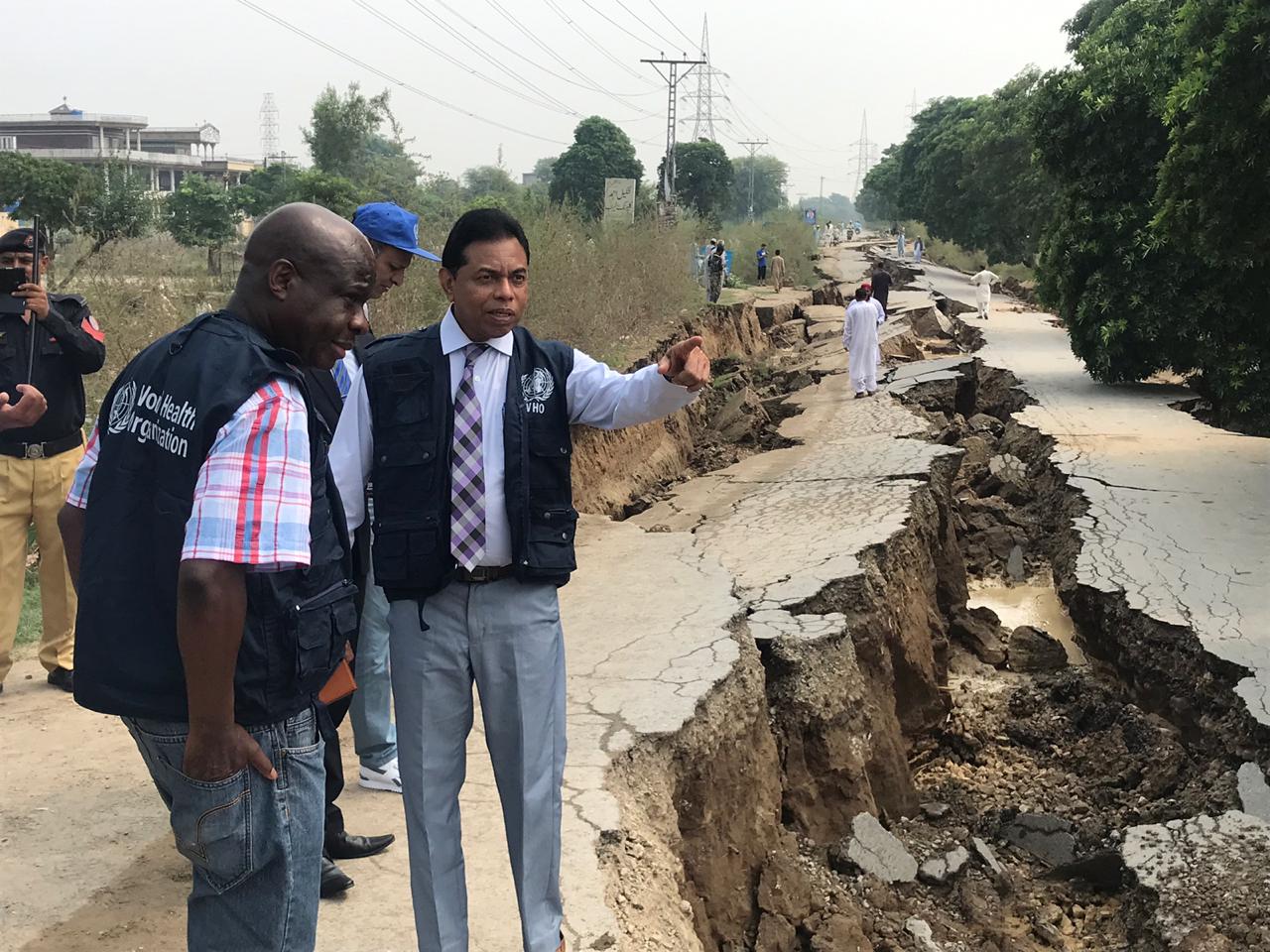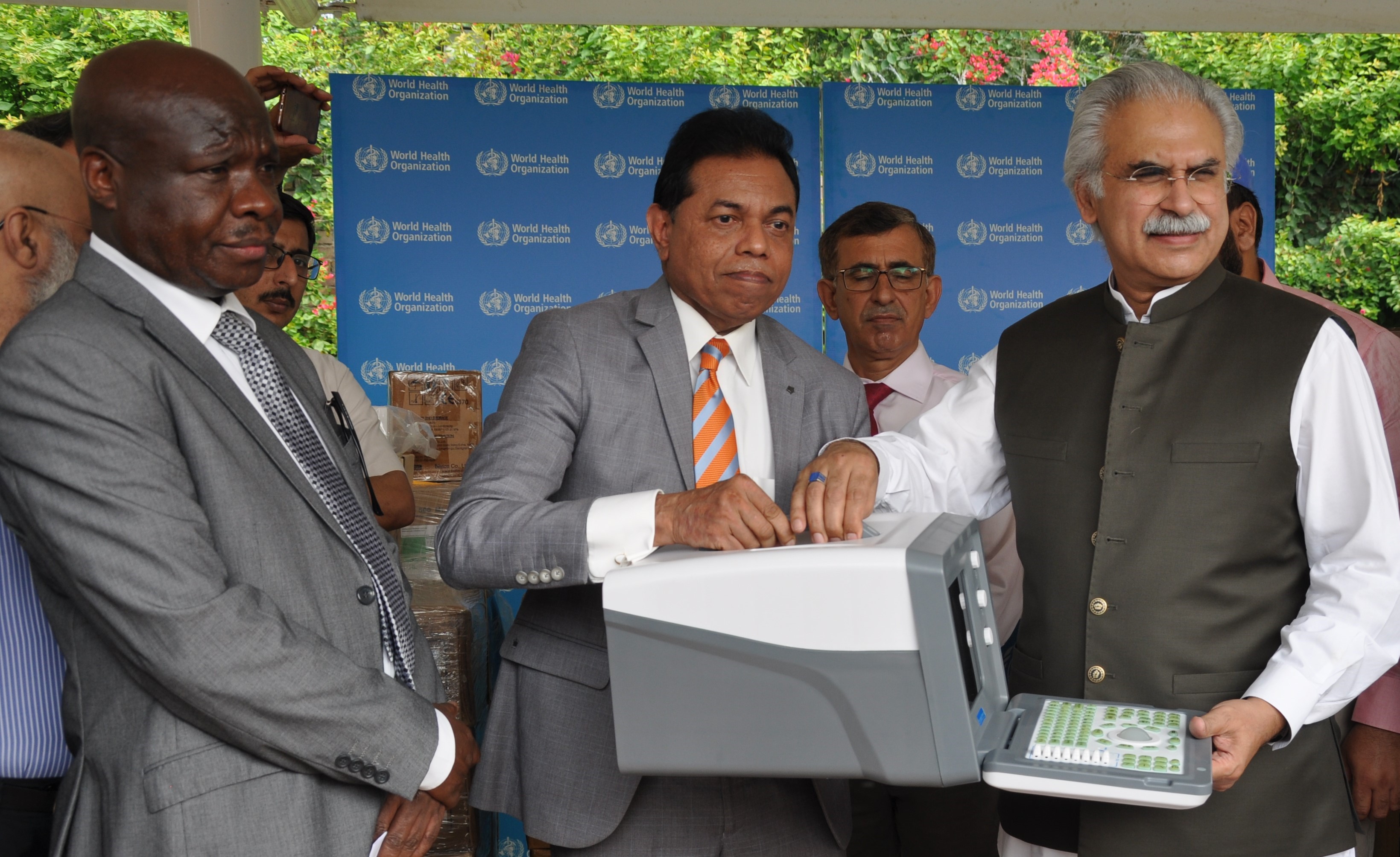The WHO Health Emergencies programme works with countries and partners to help build the capacities required to rapidly detect, respond to and recover from any emergency health threat. The programme aims to minimize the health consequences of outbreaks and emergencies by:
- helping countries to strengthen capacities to detect, prevent and respond to health emergencies;
- mitigating the risk of high threat diseases and infectious hazards;
- detecting and assessing emergency health threats and informing public health decision-making;
- responding rapidly and effectively to emergencies under a coordinated incident management system; and
- ensuring WHO's work in emergencies is effectively managed, sustainably financed, adequately staffed and operationally ready to fulfil its mission.
Pakistan is prone to natural disasters. Droughts in 2018 and 2019 in Sindh and Balochistan affected 7 million people. The flash floods of 2019 in Balochistan affected 40 000 people and damaged 15 health facilities. Pakistan is in one of the most seismically active regions in the world and experiences frequent earthquakes. The last earthquake was in September 2019, in Mirpur, Azad Kashmir. It claimed 40 lives, injured nearly 900 people and damaged health facilities and other infrastructure. In January 2020, an avalanche in the northern part of Pakistan claimed 77 lives, injured over 94 and destroyed many houses and properties.
 WHO Representative in Pakistan Dr Palitha Mahipala and the WHO Emergency Cluster Lead Dr Michael Lukwiya visit Mirpur in September 2019 one day after the earthquake to conduct an onsite assessment and donate essential medical supplies
WHO Representative in Pakistan Dr Palitha Mahipala and the WHO Emergency Cluster Lead Dr Michael Lukwiya visit Mirpur in September 2019 one day after the earthquake to conduct an onsite assessment and donate essential medical supplies
The tribal areas of the Khyber Pakhtunkhwa province (previously called Federally Administered Tribal Areas) have made tremendous progress in recovering from situations of humanitarian crises; however, still require ongoing support in recovery efforts.
Pakistan has also experienced several disease outbreaks in the last 4 years, including the extensively drug-resistant (XDR) strain of Salmonella Typhi, which emerged in 2016. This outbreak resulted in over 3700 cases in 2018, and surpassed 7000 cases by 2019.
In 2018, there was an outbreak of leishmaniasis with more than 90 000 cases in the provinces of Balochistan and Khyber Pakhtunkhwa, and at least 5 localized outbreaks of measles across the country producing nearly 7000 cases.
An outbreak of dengue fever was reported in July 2019 in Khyber Pakhtunkhwa, leading to 47 120 confirmed cases and 75 deaths in the 4 provinces along with Islamabad, and Azad Jammu and Kashmir.
In 2018, 160 000 people were living with HIV in Pakistan and in 2019 an upsurge in HIV cases was observed in the city of Ratodero of Sindh in which 1100 people tested positive for HIV, 900 of whom were children. Pakistan continues to experience localized outbreaks of influenza (H1N1, H3N2).
The first case of COVID-19 was reported in Pakistan on 26 February 2020 and since then, the total number of cases in the country has exceeded 250 000, with over 5400 deaths.
 WHO Representative delivers medical supplies and equipment to the Special Advisor to the Prime Minister on Health Dr Zafar Mirza
WHO Representative delivers medical supplies and equipment to the Special Advisor to the Prime Minister on Health Dr Zafar Mirza
WHO's response to COVID-19
WHO's response to the COVID-19 outbreak since March 2020 has included:
- establishing multisectoral, multi-partner coordination mechanisms to support COVID-19 preparedness and response efforts;
- supporting case management through training health workers and procuring and donating medical supplies and equipment;
- implementating a risk communication and community engagement strategy and engaging religious leaders and academic associations;
- supporting COVID-19 surveillance (monitoring of transmission and contact tracing) and case investigation, collecting, analysing, disseminating and utilizing epidemiological data to guide public health interventions;
- establishing and training rapid response teams;
- strengthening points of entry surveillance through training, establishing information booths, procuring and donating supplies and other equipment, including thermo guns;
- strengthening laboratory capacity through training, procuring and distributing laboratory supplies and equipment; daily testing capacity has increased from 200 to over 50 000 in 4 months;
- ensuring the safety of health care workers by implementing infection, prevention and control strategies, training them in IPC measures and donating personal protective equipment;
- supporting the development of various plans and guidelines for COVID-19, including the national action plan, national laboratory testing strategy and guidelines, a preparedness and response plan, a socioeconomic plan for COVID-19;
- implementing the essential health services plan for continuing the provision of essential services during the COVID-19 pandemic, including maternal and child health services, immunization and communicable disease control;
- contributing towards research and development by conducting a case-control study (to understand the risk factors and co-morbidities of COVID-19 mortality in Khyber Pakhtunkhwa); and a nationwide seroprevalence survey (to ascertain the prevalence of COVID-19 in the population);
- providing regular briefings to over 50 donors, partners and ambassadors of over 25 countries on Pakistan's health needs.




